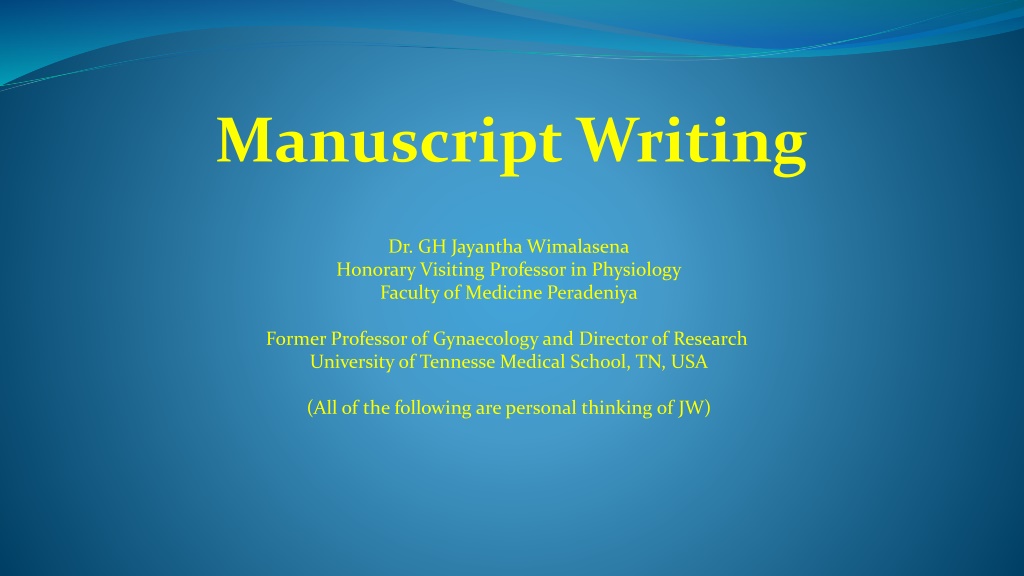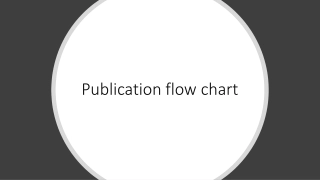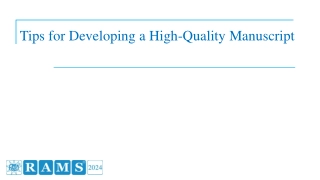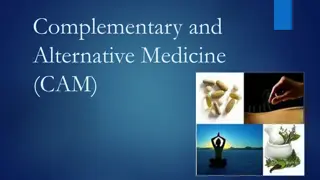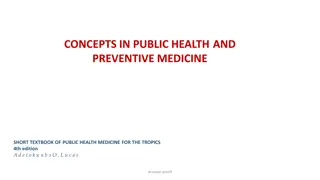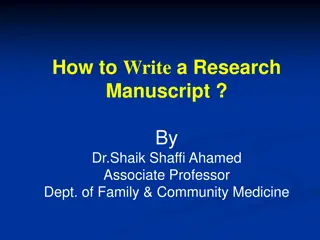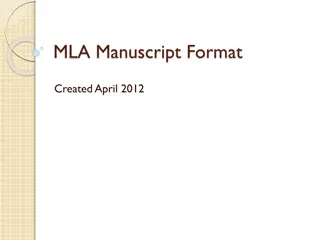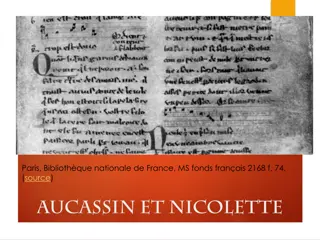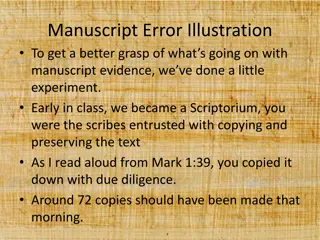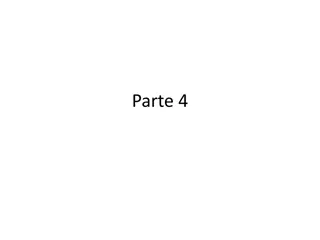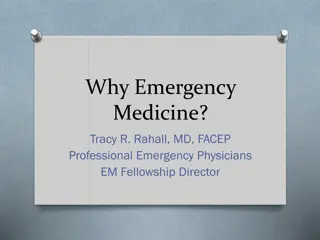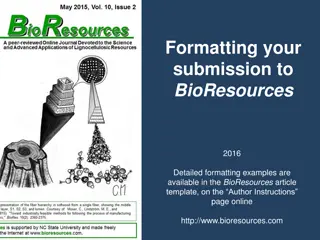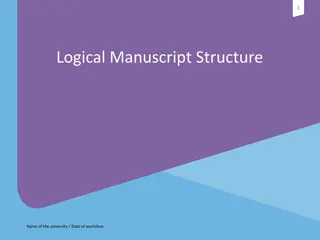Understanding the Essence of Manuscript Writing in Science and Medicine
Exploring the concept of originality in scientific manuscripts, this piece delves into the pivotal role of observations, literature review, hypothesis testing, and statistical soundness in developing a compelling manuscript in the realms of science and medicine.
Download Presentation

Please find below an Image/Link to download the presentation.
The content on the website is provided AS IS for your information and personal use only. It may not be sold, licensed, or shared on other websites without obtaining consent from the author. Download presentation by click this link. If you encounter any issues during the download, it is possible that the publisher has removed the file from their server.
E N D
Presentation Transcript
Manuscript Writing Dr. GH Jayantha Wimalasena Honorary Visiting Professor in Physiology Faculty of Medicine Peradeniya Former Professor of Gynaecology and Director of Research University of Tennesse Medical School, TN, USA (All of the following are personal thinking of JW)
What is a Manuscript Classically it referred to a Book of writing but the essential ingredient was the originality of the work.
Manuscript in Science and/or Medicine The Key concept is Originality but in a scientific sense originality is relative and the work is not a creation of the authors mind. The author or authors usually but not always make an observation on a natural subject or patient or cultured cells or even a test tube reaction. The author(s)then access the literature to seek if similar observations have been made by others. If so, how far did the other observers progress is a key question. On the other hand if the observation ( E.g.:- some unknown constituent of food caused a sharp drop in BP) is unique then most authors would be more Excited after all it s Original observations that have earned Noble prizes.
Classic example is that in petridishes bacterial lawns were lysed by growth of mold (Fleming). This single observation (which most scientists would have discarded as nuisance!) changed the whole of human history. if you are very lucky and /or observant you made an original observation which could be repeated by you and others in the same setting. After a exhaustive literature search you develop a hypothesis which can be tested. Now you have the beginning of a Manuscript which usually takes the following path
Observation Literature review Testable hypothesis Idea of Manuscript (final goal) Development of a model Experiments in the model system(could be human or other) Is the experimental system statistically sound (e.g. power). Absolutely critical in human/animal models Results Manuscript
1. The title The number of words here is restricted by journals. Authors should always spend some time contemplating the title. Because more often than not readers are attracted or not by the title (similar to a headline in news paper). Remember that readers are almost always other scientists who are usually very busy.
The title should state very briefly the contents of the paper. E.g. Compound X in a soy bean containing diet may transiently depress BP (this assumes that you have made substantial progress) o In this title you are not claiming that only compound X is causing a drop in BP. Soy containing diets may have other compounds (known or unknown) that change BP. o But this title is far better than soy bean containing diets may transiently depress BP which is vague title since there may be dozens of compounds in soy that depress BP. o Your readers may simply dismiss the resulting paper as another unknown cause for depress BP.
Given that key words are extremely important in title searches, you must include those that `direct the Manuscript to the audience.
Obviously your audience will include Biochemists Nutrients Physiologists Clinicians Pharmacologists Perhaps Pharmaceutical companies( who are always seeking clinically useful compounds or to remove potential toxicities of compounds under development) Companies which market natural food compounds as health aids. (these products are not regulated by FDA and similar bodies) 1. 2. 3. 4. 5. 6. 7.
So the key words could include a biologically active compound X (a chemical) Soy bean Diet BP Transient effect( a transient effect may have mechanistic implications in comparison to a prolong effect) Therefore a key word search for any of the above will bring up your paper Other keywords should come from the abstract
2. Abstract In my Opinion this is the most important part of a manuscript. Strict limitation on number of words. It is the part that read by the journal editor s staff, the reviewers, and by potential readers. Since many computer algorithms search both the title and abstracts, key words derived from here should be in your keyword list
A good abstract contains 1. One sentence introduction Example:- Soy is known to have many biologically active compounds 2. Brief statement on why the work was done Example:- We observed that food containing soy transient reduction of BP and wanted to elucidate the mechanism.
3. Brief ( say 3 statements ) of your main results 4. A conclusion statement of why this work is important and precisely what s novel in it. Example:- We identified that cooked soy contains a novel hypotensive agent,(X) which transiently lowers BP by inhibiting a receptor (Y). This agent X by suitable chemical modification may be developed in to a clinically useful hypotensive, such a statement is bound to make your audience sit up.
3. Introduction (Remember that all journals restricts number of words in a manuscript) The Introduction introduces your work to the readers usually in less than a journal page. It should include a background statement which can be a expansion of that in the abstract and in our case would be a summary of biologically activities of soy when taken as food.(Here cite mainly published reviews) The biological activities of soy as a food constituent should be discussed briefly and in particular any known effects on the CVS.
Is there any evidence for CV effects of soy derived chemicals, especially a heart stable compound? Then briefly allude to heart stable substances from food which can change BP especially transiently If you have identified the chemical X a summary of known effects of X or closely related compounds would be useful( write references)
Briefly describe your initial observation on transient BP change and what lead you to conclude that X is the active ingredient. If you have identified a mechanism of action for X then include a statement on this. Conclude with a statement on what s novel in the work and how it is applicable to Medicine.
4. Methods This section in principle should have sufficient detail for another scientist to repeat your work. However this is rarely the case. If you have developed a new method it is your obligation to describe it in detail For an example it is possible that you have modified chemical extraction X or in developing a mechanism of action of X.
If the methods are identified to those previously described then all you are required to do is to provide appropriate citations. Since the study uses humans (and animals to test mechanisms) it is critical that to us adequate statistical methods. Most journals will reject submissions which do not use appropriate statistics. Since most biomedical scientists have a poor understanding of statistics do not fool your self consult a qualified statistician.
5. Results Start with your initial observation .Note that many authors investigate controversies in the literature if the topic is something they are working on or interested in. In this case you should have described the controversies in the introduction and even in the abstract. All of your readers want to know why you did your work!
In the case of a controversy simply state :PQ et al showed that a compound Y bound to receptor A increase BP, but this was refused by MN et al. There for we wanted to establish if Y is against at A. In general this kind of investigation occurs when you have been working on receptor A and have ill-defined results!
Always try to present your data in graphs because most of us like to read graphs rather than tables and the latter obviously cannot show kinetics. However if you had n=25 in your test and n of 25 in your control you will have to have a table with appropriate statistics. Then you can present the graph as atypical results. Do not repeat which is in a graph/table in words
Please appreciate that your reader (this includes the reviewers) is not blind and is at least as intelligent as yourself! Present your data in a logical sequence and do not present them haphazardly In our case
Initial observations A Hypotensive compound in cooked Soy Which reduce BP transiently (controls who consumed similar food w/o soy no effect) Isolation of X from cooked Soy (this would be a difficult time consuming process which requires collaboration with analytical or biochemists) Identification of X as a peptide Test of compound X in humans/ animal models. Did it reduce BP transiently? (I am not considering potential counter effects of other vasoactive factors in soy) Is soy extract w/o X inactive? Identification of receptor for X ,for instance in vascular smooth muscle
Why is the effect transient? Receptor gets desensitized to X Peptide has a short half- life X is internalized and inactivated Feedback correction of vascular tone Normal BP
So in this IDEAL situation (which unfortunately does not happen!) The results are presented in a highly logical sequence Last statement could be we have identified a novel vasoactive peptide in Soy
6. Discussion (Usually 1-1.5 pages) The purpose of this is to place your results in the context of what s already published. It is unlikely that a manuscript would be rejected based on the discussion, but a good discussion will be like icing on a cake . A wavering reviewer may accept a manuscript if the discussion offers a balanced view of your results in the context of what is in the literature.
In other words do not exaggerate your results! The discussion should start with a brief summary of your key data. State what you think are the problems with the results and possible alternative interpretations of the data. E.g. Could X be a contaminant in Soy arising contamination?. Did you test from a fungal covered sources of Soy?.
The discussion expands on what was introduced in the introduction E.g. If could elaborate on vasoactive compounds in food sources and in particular peptides. You may want to comment on your extraction procedure and whether others may be able to use it. An excellent fact you may want to discuss is the theoretical basis for identification of the peptedergic receptor. You can speculate on the mechanism of action of the peptide for an example is it regulating cGMP?. Are there known endogenous peptides which may act on the same receptor example;- is X is a mimic?
Why would Soy produce a peptide like X Example- could it have a function in plants? Is X a selective for certain vascular beds. So the discussion allows you to be creative (with in limits) and show the reader that you are a good thinker and not merely a technician!!
7. The review This is of course what is most important for dissemination of your results! If you cannot convince the reviewers your efforts come to naught!
Generally its an excellent idea to have your manuscript examined critically by 2-3 in house reviewers. 1. In our case a person conversant with CV effects of natural compounds. 2. An expert on extraction of vasoactive compounds especially peptides 3. A pharmacologist who specialist on peptidergic receptors.
Ask your reviewers how you should make corrections /modifications. Can they provide alternative hypothesis for your results?. A detailed review is a time consuming process. So your reviewers should have the time and a genuine desire to help you! Ask your friendly reviewers their choice for publication of your manuscript.
Select the journal very carefully, my first choice was always one of the highly recognized journals based on reputation in the field and impact factor (a librarian can provide a list of reputed journals in any field based on the ISI Impact factor. Many high Impact Factor journals are published by medical/scientific societies. For this work I would consider Pharmacology and Experimental Therapeutics, Molecular Pharmacology, both published by American society for Pharmacology and experimental therapeutics.
Another good choice given the biochemistry-molecular biology content is the Journal of Biological Chemistry (American society for Biological Chemistry and Molecular Biology). Circulation Research and Circulation given the central observation on BP All of these have good very good Impact Factor (4-10). In choosing the journal one should carefully look at the members of the editorial board Are there experts there who work on similar issues? If so, they are likely to be interested in being the sub editor for your paper and most likely choose competent Reviewers. Not all reviewers are fair or worse, competent!.
Reviewers may work on similar areas and have a conflict of interest. Many journals have a policy of rapid review by a sub editor and if they are not interested they will give a verdict within a week. With other journals you won t know anything for 2-3months. A cardinal fact to remember is that with any good journal the acceptance rate is <30% even after 2-3 revisions! The rejection usually occurs in the 1stround of review, so put your best foot forward , Consider carefully the critique by your in house Reviewers or Refs and send the best version you can.
Authors often overlook mistakes in data in tabular form and do not include detailed Stats. Mislabeled axes, referring to incorrect graph numbers, poor quality of graphs are common but serious mistakes. These give Refs grounds to critique and reject your manuscript. Do not send a manuscript with grammatical errors. When you write fig. legends make sure they have sufficient details so that a busy Ref can understand the graph by just reading the fig. legend. Remember many Refs are extremely busy people; they are doing this as a service (very rarely paid) and often have to review 2-3 articles with in a 2 week period. Generally a good review takes 3-4 hrs, especially if the Ref has to refer to previous publications and this is a considerable period time for the Ref.
Series of events Author(s) Submit manuscript Initial editorial review (may include preliminary review by associate editor or in house editorial staff member) ---possible rejection here Assignments to Reviewers (Refs), usually two or three 2-3 weeks for review Comments returned to editor Editor decision Author
If you choose a society journal the associate editor may actually read the reviews If the reviews are in disagreement this person may actually read the manuscript as the 3rd Ref. Or the Manuscript is sent to a 3rd Ref.
The advise to the Editor on acceptance by Ref is not set to the author Usually the Ref has 4 choices. 1. Accept the Manuscript. 2. Accept with minor modifications or corrections (manuscript not sent again to Ref) 3. Reconsider after major modifications (usually additional experiments) manuscript to be returned for 2nd review by Ref. 4. Reject
Editor will take a decision and transmit it to author Possible choices 1. Accept w/o any revision. Excellent! (Has never happened to presenter) 2. Reconsider with revisions (could be major or minor). Fair good. 3. Outright rejection. Sorry The editor will send you most of the refs comments (except 1-4 in the previous slide)
What you can do If it is minor corrections, do them as soon as possible and send the manuscript back. These corrections do not require new experiments or data collection. They could be mistakes discussed before (data presentation), disagreements with content of introduction or discussion (for an example you have missed references to important papers, the Ref may have done similar but not identical work in the past which was not cited.) If the Ref is reasonable he/she will not reject by stating that you have merely repeated their work. Or the Ref is aware of X, Y publications on a similar subject which you have missed. So a careful literature search is very important.
Major revisions Almost always the Ref has disagreement with your data or conclusions. Ref wants you to repeat or do new experiments to support your conclusions. Either way you have little choice but to comply with their wishes. Alternatively you could send it to a 2nd journal. However your manuscript may be sent to the same Refs again, (2nd journal)since sometimes the expertise required is limited in distribution or some potential Refs do not have time to review your paper.
So you end up by doing more experiments (or collecting more patient data, reanalyzing using other statistical methods etc.) and writing a rebuttal. You must answer each critique point by point. If you rationally feel( here you should ask for advise from your in house Refs) that the Ref is misinterpreting your data or conclusions say so. Do not be meek and say YES SIR!!
you have to write a letter to the editor along with detailed rebuttal to the critique you need to show the editor that (a) you answered all the critique point by point. (b) and or inform the editor why you disagreed with the Ref, therefore you are not doing suggested experiments. If the editor is doing his/her duty he/she will carefully balance your arguments with that of the Refs. This is especially the case if Ref 1 and Ref 2 have wide divergence of opinion. This is to your advantage as you can point it out to editor.
Occasionally Refs will raise new Qs in the 2nd round of review. This is in my opinion a No! No! It is a tell tale sign that the Ref is doing similar work and wants to delay or stop publishing your work. Or more commonly he/she has a fundamental disagreement (simply does not believe) with your results due perhaps to a basic disagreement with a key result For an example in our case Refs does not think X is the peptide you identified. The Ref is then required to present a solid case for his critique.
8. Conclusion Publishing even a solid piece of science in a respectable (not journals with IF<2) journal is increasingly a major hurdle to your progress. This is partly due to the increase in the number of investigators competing for limited space in journals (cut-throat competition like among politicians!), unethical Refs ( politicians again) who are doing similar work etc. Important message is never give up. If you (+and your in house Refs) feel that the work is solid fight back vigorously !
The presenter once had a paper returned six times by the Journal of biological chemistry. On the 6th occasion ,I wrote to the Editor that one Ref did not want to publish this work because he had failed to get the same results.( I had heard this through the grape vine ) The editor wrote Dr Wimalasena Do the following two experiments and if positive JBC will accept your manuscript. We had the results within a month and the revised manuscript was accepted with in a week. The editor was Edward G.Krebs who later received the Nobel. It is rare to find editors of his caliber these days!
In many countries like the USA the motto publish or perish is very much operative. As a academic clinician and or biomedical scientist, your whole career is decided by quality of your publications. These literally decide whether you will secure grant funding. The competition for funding from N.I.H. and other agencies is incredibly intense with < 5% success rate.
So I used to tell my students Research Publish Grants Perish Literally a never ending cycle till one retires (blissfully) Is retirement nirvana ???????
